Gerry Adams's Blog, page 62
December 19, 2013
Saying goodbye to Comrade Madiba
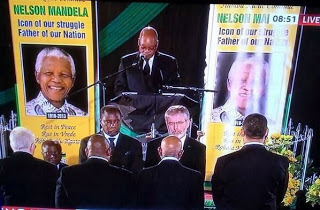 Madiba's Guard of Honour
Madiba's Guard of HonourThe green rolling grasslands of Qunu were coming alive in the early morning dawn light as we climbed down off the bus last Sunday morning. It had been a three-and-a half-hour journey from the airport at East London, in the Eastern Cape, along dark and twisting roads. Qunu is Madiba’s home and it is where he chose to be buried. As the sun slowly lifted itself above the hills, its light revealed a landscape similar to others I have seen in the west of Ireland. A big blue sky and distant homes scattered across hills. It was here that Madiba was born and had grown up. And it was to Qunu he returned. He was home with his clann after nine days of national mourning in South Africa.
Richard McAuley and I had arrived in Pretoria on Thursday. Irish republicans have a long association with the ANC going back many decades. We supported each other in struggle and in our respective efforts to achieve peace. Nelson Mandela and others in the ANC leadership were and are hugely supportive of the endeavours of Irish republicans.It was right and proper that Sinn Féin should be represented at his funeral but it was equally important that we participated as comrades in struggle honouring a comrade for whom we have the greatest admiration and respect.
Lying in stateThe day after we arrived, the ANC brought us to Union Buildings in Pretoria where Madiba was lying in state. Richard and I had been here before several times, meeting Thabo Mbeki in 1995 when he was Deputy President of South Africa and later when Thabo was President. Union Buildings are impressive. It sits on the highest hill in Pretoria looking down on the city. It is the official seat of government and is where the President’s office is located. This month it celebrated its 100 birthday and it was declared on Monday, the day after Madiba’s funeral, as a national heritage site.

Union Buildings
Between the two wings of the building is a 9,000-seat Greek-style amphitheatre which is used for national ceremonies. Nineteen years ago it was here that Madiba was inaugurated as South Africa’s first democratically-elected President. It was fitting therefore that it was here that a special protective cover was erected within which his body rested and through which two rivers of citizens passed by on either side for three days.
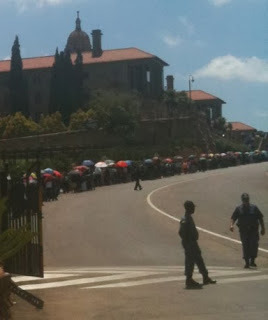
Part of the queue to Union Buildings
The queues of ordinary South Africans stretched for miles, winding their way down the hill and through the streets of the city. They began arriving at 4am each morning and waited patiently in burning heat to pay their respects to their leader. One estimate put the number of people who quietly, sombrely, respectively passed by Madiba during those three days at over one hundred thousand.
We met our ANC comrades at Oliver Tambo Building and were taken directly to the front steps of Union Buildings. We joined in with one of the steadily-moving queues of citizens. Fr Barney McAleer, a Tyrone man who has been in South Africa for almost 50 years, accompanied us.There were four military with rifles pointed down standing at each corner of the coffin. The only sound to be heard was the shuffling of feet as we all solemnly moved forward. One behind the other, we approached his remains. The top of the coffin was opened and under a glass cover could be seen Madiba.
It was an emotional moment, a deeply sad moment. Many of those passing by were crying quietly to themselves. And then we were passed.It was at this place in 1994, as he took on the mantle of President of a free and democratic South Africa, that Madiba said:
“We understand it still that there is no easy road to freedom. We know it well that none of us acting alone can achieve success. We must therefore act together as a united people, for national reconciliation, for nation building, for the birth of a new world. “Let there be justice for all.
“Let there be peace for all. “Let there be work, bread, water, and salt for all…
“Let us as a Rainbow Nation keep this in focus and move forward.”The ‘send-off ceremony’For eight days the South African Government was responsible for the state funeral of their President. But on Saturday, as they prepared to fly him south to Qunu, Madiba’s ‘send-off ceremony’ from Pretoria was given over to his comrades in the ANC and to the veterans of Umkhonto we Sizwe (Spear of the Nation), or MK, the military arm of the ANC, which Madiba founded on 16 December 1961.
The programme began at 5:30am. Robert McBride, a former MK activist and political prisoner, who has been to Ireland many times, drove us to the South African Air Force Base at Waterkloof. A huge air force hangar had been transformed into an auditorium.Two thousand specially-invited ANC and former MK activists, and international guests from liberation and solidarity movements, were present in solidarity with the family, to give an ANC farewell to their former Commander and President.
A space was left in front of a stage for the coffin to sit. As we awaited Madiba’s arrival it was an opportunity to mix and reconnect to comrades we hadn’t seen for a while. Occasionally, groups of ANC activists, many of them elderly women dressed in traditional clothes, would toyi-toyi their way back and forward across the front of the hall, chanting and singing songs of Madiba and of resistance to apartheid. It was a joyous celebration of the life of their leader, of the man they called ‘Tata’, which in Xhosa means ‘father’ and is a term widely used during the 10 days of mourning by political and church leaders, political activists, ordinary citizens and by the media. Madiba was a father to them all.
When his remains arrived at 7am, the South African national flag was removed and replaced by the flag of the ANC. Groups of activists – veterans in the main of the ANC and MK – took turns to provide a guard of honour around the coffin. We were greatly honoured when asked to participate in this. Richard and I took our assigned places and stood silently, paying our private respects to a great leader on behalf of Irish republicans everywhere.Several hours later, after messages of support from the Congress of South African Trade Unions and the South African Communist Party and others, a stirring speech by President Jacob Zuma and much music and song and poetry, the ANC flag was removed, folded and given to the Mandela family. Madiba was then taken from the hall and flown south to his home in Qunu.
Madiba goes homeA few hours after that we took a flight to East London where we met some of the other 4,000 guests invited to attend the funeral. A convoy of buses left the airport around 1am on Sunday morning for the long journey to Qunu. It was impossible to see anything of the countryside. The night was dark and there were few lights along the road except those of our buses.
Sunday was the last day of official mourning. Ten long days for South Africa and ten long days for a grieving family sharing their husband, father and grandfather with the rest of the world.Qunu is an isolated part of the Eastern Cape. For days it had rained and officials were worried that more rain could prove difficult for the funeral arrangements. But as it turned out there was no rain. The day was clear and the sky clear. It was a hot summer’s day when Madiba left his family home for the last time on the journey to the huge Marquee that had been erected to hold his funeral ceremony in.
Walking into this huge space was akin to entering a cathedral. The South African Government had succeeded in creating a beautiful space in which Madiba’s life could be celebrated. The ceiling was high, the air cool, and the colours of the huge lights changed in the course of the ceremony from blue to gold. The centrepiece of the stage was a portrait of Madiba behind 95 candles to mark each of his 95 years.On one side musicians provided music and on the other a choir occasionally raised their voices in song and filled the auditorium with vibrancy and emotion. The event was hosted by Cyril Ramaphosa, who has close associations with the Irish Peace Process. Other contributors included President of Malawi Joyce Banda and Tanzanian President Jakaya Kikwete, who recalled Madiba’s first visits there seeking support for training camps for MK and Kenneth Kaunda, the former President of Zambia.
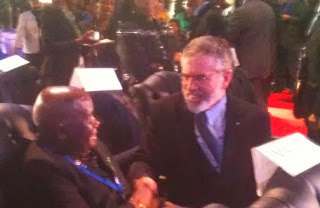
Former President Kenneth Kaunda
They all spoke movingly of Mandela’s contribution to South Africa, to Africa and to the world. They recalled his many qualities and talents. But all stressed the importance of his legacy and the need to live up to the ideals of peace and reconciliation that he exemplified.The most moving speech of those delivered was by his close friend and fellow Robben Island prisoner Ahmed Kathrada, who spent 26 years in prison. Frail and obviously distressed, Kathrada described how he and Madiba called each other ‘Madala’ or ‘Elder’. He said:
“Madala, your abundant reserves of love, simplicity, honesty, service, humility, care, courage, foresight, patience, tolerance, equality and justice continually served as a source of enormous strength to many millions of people in South Africa and the world. “You symbolise today, and always will, qualities of collective leadership, reconciliation, unity and forgiveness. You strove daily to build a united, non-racial, non-sexist and democratic South Africa.”
But at the end his voice broke with emotion as he said:“When Walter [Sisulu] died, I lost a father and now I have lost a brother. My life is in a void and I don't know who to turn to.”
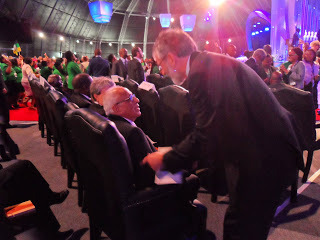 Ahmed KathradaThe gravesideAt the end of the ceremony, Madiba’s remains were taken outside the marquee and placed again on the gun carriage. Most of the 4,000 guests stayed and watched the graveside funeral on the huge video screens above the stage but we were invited to the graveside to watch and mourn as Madiba’s remains were placed in the earth. The language might be different and hymns unfamiliar but as family members placed a flower in the grave and took some dirt to drop in on the coffin the similarities with our own experience in Ireland were obvious.
Ahmed KathradaThe gravesideAt the end of the ceremony, Madiba’s remains were taken outside the marquee and placed again on the gun carriage. Most of the 4,000 guests stayed and watched the graveside funeral on the huge video screens above the stage but we were invited to the graveside to watch and mourn as Madiba’s remains were placed in the earth. The language might be different and hymns unfamiliar but as family members placed a flower in the grave and took some dirt to drop in on the coffin the similarities with our own experience in Ireland were obvious. Madiba’s grave is on top of the hillside in which a small garden has been built. It has a magnificent view of Qunu and of the hills where Madiba played as a boy.
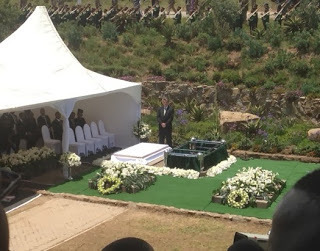
When it was over, Richard and I slowly made our way down the hillside and the bus back to East London.
Madiba is gone. But his words are all around us. The legacy of hope and courage and forgiveness and of reconciliation is one we must aspire each day to achieve. In our several conversations about the Irish Peace Process, Madiba understood at once the complexities but also the only direction we could go to avoid decades more of conflict. He supported the Peace Process in Ireland unequivocally and on the basis of equality and inclusivity. He knew that we all had to be part of solving the problems.
Richard Haass and Meghan O’Sullivan will shortly produce their proposals for moving forward on the difficult issues of flags and emblems and the past. In the days ahead as we seek to find solutions we need to remember the words of Nelson ‘Madiba’ Mandela:
“No one is born hating another person because of the colour of his skin, or his background, or his religion. People must learn to hate, and if they can learn to hate, they can be taught to love, for love comes more naturally to the human heart than its opposite.” ― Nelson Mandela , Long Walk to Freedom
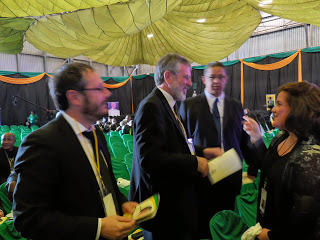 Left to Right: Basque Senator Urko Aiartza, Mise agus Robert McBride
Left to Right: Basque Senator Urko Aiartza, Mise agus Robert McBride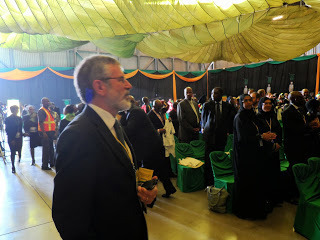
In the South African Airforce Hangar
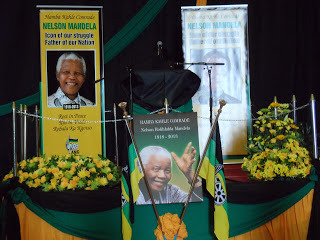 The stage before which Madiba's body lay for his 'send-off'
The stage before which Madiba's body lay for his 'send-off'
Meeting old friends - Cyril Ramaphosa
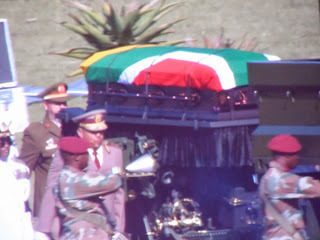
Published on December 19, 2013 03:03
December 18, 2013
The Downing Street Declaration -
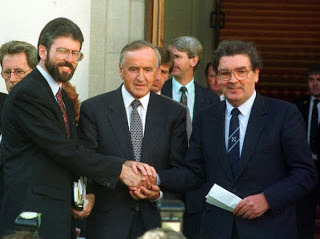 The Downing Street Declaration was 20 years old last Sunday. The first draft of this document was written two years earlier by John Hume as part of secret talks between us aimed at developing a strategy that would provide an alternative to armed struggle.
The Downing Street Declaration was 20 years old last Sunday. The first draft of this document was written two years earlier by John Hume as part of secret talks between us aimed at developing a strategy that would provide an alternative to armed struggle.Sinn Féin’s objective was to get agreement between the Irish government, ourselves and John Hume on the text of a joint declaration and the mechanisms to give effect to this, and to put in place a broad consensus on the Irish nationalist side, including Irish America, to pursue a policy towards peace and justice and to engage with the unionists on this in order to build a peace process.
At that same time alongside the Hume/Adams Talks, Sinn Féin was involved in secret negotiations with John Major’s government, secret negotiations with the IRA, secret negotiations through Fr. Reid with the Irish government, and we were involved in outreach to Irish America and subsequently with the White House. It was a very busy time but progress was lamentably slow.
John gave our draft to Charlie Haughey. The Irish government then produced an unacceptable version which was essentially a rehash of the British and Irish governments position.
At the same time the Irish political and media establishment was engaged in a ferocious campaign of vilification of Sinn Féin – what has changed you ask – which saw Sinn Féin denied the use of the Mansion House and other public buildings for our Ard Fheis.
In January 1993 Albert Reynolds became Taoiseach and introduced a new dynamic into the negotiations. Notwithstanding the shortcomings of this process Mr. Reynolds was by far the best of the Taoisigh to deal with the north.
Charlie Haughey who preceded him had refused to open up talks between his government and Sinn Féin. The delegation which eventually met Sinn Féin was representing Fianna Fáil and not the Irish government, and although that was an important and positive development, there was no real progress made on Mr. Haughey’s watch in terms of an inclusive all-party negotiating process.
Both British and Irish systems had – and still have - one thing in common. They were cautious and wedded to old policies. The Dublin system was also, and remains partitionist, and limited therefore in its thinking and policy development. There were exceptions among the senior civil servants but most of them had spent years dealing with the SDLP and despite Sinn Féin significant mandate they weren’t minded to upset that relationship.
Albert Reynolds had a different style. He brought a directness in how he addressed the potential for progress. Of course he had, as did all Taoisigh, to deal with his own system. The same is true also of British Prime Ministers. Tony Blair has publicly recalled that he was only able to do what he did in 1997 and 1998 because he was a new Prime Minister and it was the heady days of a new government. So too with Mr. Reynolds.
Albert had many contacts in the north from his business activities, including the dance hall business. He had an appreciation of the potential and of course he would have been briefed by his predecessor so he opened his door to Fr. Reid. His coalition partner Dick Spring was much more conservative in his approach. Some of his interventions were unhelpful.
In April 93 the story broke that John Hume and I had been talking and we issued our first joint statement. In it we asserted that the most pressing issue facing us and the people of Ireland was lasting peace and we agreed that a process of national reconciliation was needed.
The result of this was a further barrage of media condemnation, particularly of John. It was vicious. I was regularly subjected to media vilification by that point but for the first time John was the target of a torrent of abuse led by the Independent group of newspapers. Many of the same journalists and columnists have maintained this approach in the following two decades.
The British government, led by John Major, said no to Hume- Adams. The two governments then engaged in a series of rewrites of it.
In November the secret talks between Sinn Féin and the British government became public. At first the British tried to deny it but eventually they were forced to come clean.
The Dublin based papers intensified their attacks on Hume-Adams. John was particularly targeted again. It was almost as if the southern political and media establishment saw him as a traitor to their conservatism. The Sunday Independent in one edition ran 7 separate articles attacking him – some in the most vitriolic and offensive language. After the Shankill bombing and the Greysteel massacre the media onslaught continued. John collapsed and was rushed to hospital. Despite, or, maybe because of, the ferocity of the media attacks nationalist support for Hume-Adams grew.
The British continued to favour inter-party talks without Sinn Féin but Albert Reynolds now indicated his backing for a joint declaration.
The Downing Street Declaration was published on Wednesday 15thDecember with a great deal of spin.
But within hours of it being launched public statements by Reynolds and Major indicated that real differences existed between both governments, not only on the actual meaning of significant and substantial parts of the Declaration, but on its stated objectives.
There was an obvious need for clarification from the governments of what this declaration meant in reality. But John Major rejected my request for clarification declaring that the Declaration was non-negotiable.
In a letter to him I asked that he authorise direct talks with Sinn Fein only in the context of clarification – not negotiation. I spelt out the three main areas of concern for republicans around the Downing Street Declaration. These were: textual matters in the Declaration itself, conflicting interpretations of the Declaration and the processes envisaged by it.
Major didn’t reply. I wrote again in April 1994. A letter from Roderic Lyne, John Major’s private secretary told me to read the Declaration.
Mr. Reynolds then suggested to us that he would seek clarification on our behalf. Martin McGuinness held a series of meetings with Martin Mansergh who was representing the Taoiseach. And the Sagart – Fr. Alec - was constantly on the road between Belfast and Dublin. When clarification eventually came, with the British under pressure responding to 20 questions we had submitted, it supported Sinn Féin’s view that the Downing Street Declaration was in many ways an ad hoc and not so well drafted response to Hume Adams.
The flaws in the drafting were not the fault of the drafters. They were evidence of the different types of pressure on the two governments. So while the declaration was a significant development that was all it was.
Like the Sunningdale Agreement in 1973, and the Anglo-Irish Agreement in 1985, the Downing Street Declaration was intended by the British government and some in the Irish government to be the end of the matter. The line in the sand. And like those agreements before it, it was neither.
Had Sinn Féin accepted the Downing Street Declaration it is arguable that there would never have been a Good Friday Agreement. Bertie Ahern and all involved deserve credit for this accord. But Albert Reynolds was the Taoiseach who welcomed John Hume and me into Government Buildings on September 6th1994.
His wife Kathleen and their family also welcomed me into their home and we enjoyed copious cups of tea during the ups and downs of that time. His was a relatively short term as Taoiseach but Mr. Reynolds ended exclusion, formal censorship and brought the Irish government in from the cold.
Published on December 18, 2013 05:01
December 10, 2013
Nelson ‘Madiba’ Mandela – Freedom Fighter
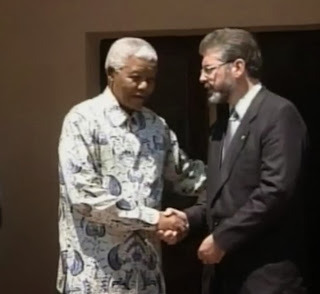 Sinn Féin President Gerry Adams TD speaking in the Dáil this evening on the death of Nelson ‘Madiba’ Mandela said: “Madiba was a leader who by his courage demonstrated that it is possible to reconcile differences.
Sinn Féin President Gerry Adams TD speaking in the Dáil this evening on the death of Nelson ‘Madiba’ Mandela said: “Madiba was a leader who by his courage demonstrated that it is possible to reconcile differences. By his example he showed us that it is possible to build peace out of conflict; something we try to do in our own island; and that a better and more equal future based on fairness is possible, and that unity can be forged out of division.”
The Sinn Féin leader who will be travelling to South Africa tomorrow for the funeral of Madiba reminded the Dáil of the close relationship between Irish republicans and the ANC. He said: “In jail for those decades, on Robben Island, Madiba maintained his international perspective.
In his cell, in common with all political prisoners, he was allowed as a privilege a calendar on which he marked significant events.
On the 5th May 1981 a simple single line is written: ‘IRA martyr Bobby Sands dies.’
A tribute, hand written, on a paper calendar on a cell wall in South Africa which recognises the bond of those who struggle for justice. His note on that prison wall is recognition of the courage and self-sacrifice of the 10 republican hunger strikers of our time. Walter Sisulu later told me that all of the ANC prisoners marked and commemorated each of the hunger strikers who died, including Kieran Doherty TD.”
The full text of Mr. Adams speech:
“Ba mhaith liom mo chombhrón a thabhairt do chlann an iar-Uachtarán Mandela, Uachtarán Zuma, daoine ón Aifric Theas, agus pobal na hAfraice in Éirinn.Taoiseach, Nelson Mandela ‘Madiba’ was truly remarkable.
He was a Freedom Fighter, a political prisoner, a negotiator, a healer, a peacemaker, a father, a grandfather and a husband.
He was a friend to those engaged in the struggle for justice across the globe.
He believed in Ubuntu (we are all interconnected and a person cannot exist separate from society; we all have responsibilities to each other).
He was a friend to the people of Ireland and many people here were his friends, particularly the heroic Dunness Store strikers who took a stand when those in power did not.
The injustice of apartheid was an obscenity – an obscenity to humanity – and in terms of our own experience Vorster – an apartheid Minister in South Africa once said famously that he would swap all of the apartheid laws for one clause of the infamous Special Powers Act in the north.
The ANC was banned, censored and political actions were quashed.
In the 1950’s and early 60’s ANC activists debated how best to challenge the state.
Speaking of that period, Mandela said, ‘We have always believed in non-violence as a tactic; where conditions demanded that we should use non-violence we would do so; where the conditions demanded that we should depart from non-violence we would do so.’
He came to the opinion that the ANC "had no alternative to armed and violent resistance.” His words not mine.In 1961 along with Walter Sisulu and Joe Slovo, Madiba co-founded and became Chairman of the armed organisation Umkhonto we Sizwe (Spear of the Nation), known as MK.
MK engaged in military actions against the South African regime through the period of his imprisonment and following his release.
And in jail for those decades, on Robben Island, Madiba maintained his international perspective.
In his cell, in common with all political prisoners, he was allowed as a privilege a calendar on which he marked significant events.
On the 5th May 1981 a simple single line is written: ‘IRA martyr Bobby Sands dies.’
A tribute, hand written, on a paper calendar on a cell wall in South Africa which recognises the bond of those who struggle for justice.
His note on that prison wall is a recognition of the courage and self-sacrifice of the 10 republican hunger strikers of our time.
Walter Sisulu later told me that all of the ANC prisoners marked and commemorated each of the hunger strikers who died, including Kieran Doherty TD.
Today the world is in mourning.
The people of South Africa have lost their leader, their father and humanity has lost our greatest statesman.
Madiba was a leader who by his courage demonstrated that it is possible to reconcile differences.
By his example he showed us that it is possible to build peace out of conflict; something we try to do in our own island; and that a better and more equal future based on fairness is possible, and that unity can be forged out of division.
In the hard years when the western powers were against him, when he was vilified as a terrorist; when he was denounced as a criminal, he kept the faith.
He showed perseverance and vision.
There are lessons in all of this for us but particularly for the people of the island of Ireland, of all persuasions, as we continue the necessary and challenging task of building the peace.
I first saw Nelson Mandela when he visited Dublin in 1990.
hat was the day the Irish soccer team returned home. And when Madiba appeared a section of the crowd began to chant 'Ooh ahh Paul Mc Grath's Da'.
So, the good humour of Ireland shone through.
In 1995 myself, and several other Sinn Féin activists travelled to South Africa at the invitation of the ANC to speak to senior figures who had been centrally involved in the process of negotiations.
That was when I met Madiba for the first time.
One of the first demonstrations I ever attended was in Dublin against apartheid and the visit of the Springbok Rugby team. And I have been a long-time supporter of the Anti-apartheid movement.
So I was delighted to be meeting with one of my heroes.
During the conflict there was a close working relationship between Irish republicans and the ANC.
And the late Kader Asmal who did tremendous work in the leadership of the Irish anti-apartheid movement, along with his wife Louise, and who was not a supporter of the IRA in his book mentions mentioned by Minister Burton, tells how the IRA provided practical training and advice and assistance with military operations to MK.
Kader says that the famous attack of May 31st 1980 on Sasal Oil Refinery near J’Burg was carried out with the assistance of the Irish Republican Army.
Walter Sisulu, Cyril Ramaphosa, Thabo Mbeki, Ronnie Kasrils and many others who were in the leadership of the ANC were pleased to remember the long commitment, as was Madiba himself, of Irish republicans to their cause.
And of course for our group the highlight of the very intense process of meetings was with Madiba.
He was self-effacing, he was modest, he was totally relaxed and he was very focused.
He was also very tough, stubborn, determined and committed as he needed to be to survive apartheid; to survive over two and a half decades in prison with hard labour.
He was immovable on core principles, on core values, on core issues but pragmatic on tactics and other matters.
It is also interesting that the British government at the time lobbied hard for Madiba not to meet me.
And when it was clear that the ANC was determined and Madiba was determined that the visit should go ahead the British lobbied for no handshake or photograph.
He ignored them.
So, I along with other Sinn Féin representatives have been privileged and deeply honoured to meet Madiba many times after that; in South Africa, here in Ireland and Britain.
Ba pribhiléid mór é dom gur bhuail mé leis cúpla uair.
He was always hugely supportive of the Irish peace process.
On several occasions senior ANC and former MK activists visited Ireland and went into the prisons and talked to republican prisoners about the peace process.
He had an enormous depth of understanding of the twists and turns of our process.
And he knew there was an onus on governments, as well as those involved in struggle, to resolve issues.
I believe as all thinking people believe that there is an onus “to create the necessary environment for peaceful solutions.”
Despite his age and even when I last met with him, despite his increased physical frailty his mind was as sharp as a razor; conversant with world affairs and with the affairs of his own continent, with for example the injustice of the war in Iraq or Afghanistan.
He was a very remarkable human being.
I mo thuairim ba é Nelson Mandela ceann de na ceannairí is fearr a raibh riamh ann. 'Sé mo laoch. Mo Ghile Mear.
All of us remember the very special occasion of the Special Olympics that were held here in 2003.
It was such a marvellous, wonderful historic event and we met afterwards and Madiba was taken by all of the young athletes that he had met in the course of that great event as he was about issues to do with the north, and the need for governments to move on the necessary business of building peace.
He will continue to inspire. He will continue in death as he did while alive to encourage oppressed peoples everywhere.
And in that way his legacy will live on.
You don’t have to be a Nelson Mandela, you don’t have to be a Madiba, we only have to do the small things we can do to make things better for those who suffer from injustice, for those who are deprived, for those who don’t have freedom.
If we all did that in a small way then those heroes like he would not have to do the big things that they have had to do.
Walter Sisulu was a wonderful man. A life long conspirator, political prisoner, and comrade to Nelson Mandela and when he died – any of you have the time you should read Mandela’s farewell – and I repeat just one line of it for this occasion.
Go well, Rest in Peace, Madiba Hero among heroes.
Ar dheis dé go raibh a anam dílis.
Published on December 10, 2013 11:31
December 6, 2013
Comrade Madiba - Nelson Mandela
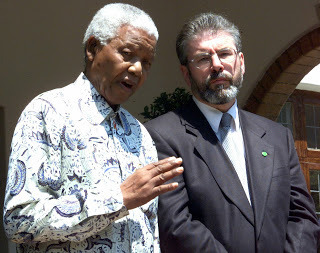
I want to extend to the family of President Mandela, to President Zuma and to the people of South Africa, my sincere and heartfelt condolences at the death of Madiba on my own behalf and that of Sinn Féin.
The world is in mourning. We have lost our greatest statesman. Madiba was a leader who by his courage demonstrated that it is possible to reconcile differences. By his example he showed us that it is possible to build peace out of conflict; a better and more equal future based on fairness, and unity out of division.
In the hard years when the western powers were against him, when he was vilified as a terrorist and a criminal, he kept the faith. He showed perseverance and vision. There are lessons in all of this for us but particularly for the people of the island of Ireland as we continue the necessary and challenging task of building the peace.
I first saw Nelson Mandela when he visited Dublin in 1990. That was the day the Irish soccer team returned home. When Madiba appeared a section of the crowd began to chant 'Ooh ahh Paul Mc Grath's Da'. The craic was ninety. In 1995 myself, and several other activists travelled to South Africa at the invitation of the ANC to speak to senior figures from that party who had been centrally involved in the process of negotiations. That was when I met Madiba for the first time.
It was almost a year after the IRA cessation and just over a year since the first post apartheid election which returned Madiba as President of a Free South Africa. Myself, and several colleagues travelled there at the invitation of the ANC to speak to senior figures from that party who had been centrally involved in the process of negotiations.
The ANC also arranged meetings with representatives from the National Party, General Constand Viljoen leader of the Freedom Front Party and Dr. Niel Barnard the head of the Apartheid regime’s National Intelligence Service.
In developing the Sinn Fein peace strategy toward the end of the 1980s and into the early 1990s Irish Republicans had recognised the importance of the international community as an ally for making progress in a peace process and as a source of inspiration and information for our own endeavours.
While much of our focus was on Irish-America, which had the greatest concentration of the Irish diaspora, Irish Republicans had always had a close affinity with the struggle in South Africa. In my youth one of my first demonstrations was in Dublin against apartheid and the visit of the Springbok Rugby team. I was a long time supporter of the Anti-apartheid movement. The purpose of our trip in 1995 was to learn the lessons of South Africa’s approach to conflict resolution, and to brief people on the difficulties in our process.
Walter Sisulu, Cyril Ramaphosa, Thabo Mbeki, Cheryl Carolus and many others in the leadership of the ANC made us very welcome. However, for all of our group the highlight of our many meetings was with Madiba. He was self-effacing in his humour, totally relaxed and very focused.
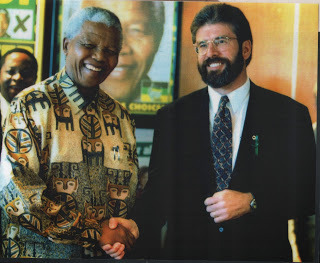 As ever the British government, and sections of the British media, had made much about whether or not there would be a handshake, would there be a photograph and so on. The Major government had lobbied hard for Mandela not to meet me. His response was simply put as we shook hands in his office:
“Ah, comrade Gerry, I’ll not wash my hand for a week.”
Madiba thanked me for the solidarity that Irish republicans had extended to the ANC and the anti-apartheid struggle over many years.
As ever the British government, and sections of the British media, had made much about whether or not there would be a handshake, would there be a photograph and so on. The Major government had lobbied hard for Mandela not to meet me. His response was simply put as we shook hands in his office:
“Ah, comrade Gerry, I’ll not wash my hand for a week.”
Madiba thanked me for the solidarity that Irish republicans had extended to the ANC and the anti-apartheid struggle over many years.It was my privilege to meet Madiba many times after that; in South Africa, in Ireland and Britain. He was funny, engaging and modest and hugely supportive of the Irish peace process. Along with his comrades in the ANC he was very helpful and he had a depth of understanding of the twists and turns of our process.
He was very loyal to those, including Irish republicans who had helped the ANC in difficult times. His outreach to Sinn Féin in the '90's was resisted stridently by the British Government and criticised by sections of the media.
In 2001, on the 20th anniversary of the hunger strike, I travelled to South Africa to unveil a monument to the hunger strikers, in the yard in Robben island prison where Madiba spent much of this time imprisoned. As part of that visit Madiba and I met again and spent several hours talking about the Irish peace process and the changing face of South Africa.
In 2003 he visited Dublin to open the Special Olympics at Croke Park. Martin McGuinness and I met him privately for discussions. Despite his age and increased physical frailty his mind was as sharp as a razor; conversant with the twists and turns of our process as well as the affairs of his own continent or the injustice of the war in Iraq.
Madiba was a very remarkable human being. At our first meeting his commitment to the Irish peace process was obvious. Nelson Mandela remains one of my heroes and in my view the greatest political leader of our time. ‘Se mo laoch. Mo Ghile Mear.’
Madiba will continue to inspire and encourage oppressed peoples everywhere. His legacy will live on.
In the words he used to salute his friend and comrade Walter Sisulu.
Hamba Kahle, Madiba. Qhawe la ma Qhawe!
(Go well, Rest in Peace, Madiba Hero among heroes.)
‘For to be free is not merely to cast off ones chains, but to live in a way that respects and enhances the freedom of others’. Madiba
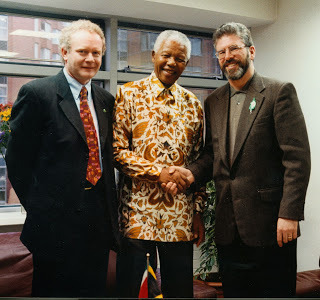
Published on December 06, 2013 07:07
December 5, 2013
What I said reflects what is recorded by Justice Smithwick
Sinn Féin President Gerry Adams TD commenting on criticisms of his remarks on the Smithwick report said:“I am very conscious that at the heart of this issue are two bereaved families. I did not need reminded of this by any of my political opponents and I am concerned, as I was during the Newstalk interview, not to say anything which detracts from that or which causes any further hurt. That was never my intention.What I said reflects what is recorded by Justice Smithwick.So those who attack me are at odds with what is contained in the Smithwick report.It is nonsense to suggest that I was blaming the two RUC officers for their own deaths. Everyone knows the IRA was responsible. That was never in question.There is also no question but that the Smithwick report records serious concerns about the security arrangements for RUC officers travelling to Dundalk through South Armagh. These include the fact that information about possible IRA attacks on RUC officers crossing the border was passed to Garda Headquarters and passed by it to the RUC.It is a fact that RUC Officer Bob Buchanan was crossing the border on average 10 times each month and on most occasions he travelled in his own car which was ‘readily identifiable .’In his report Justice Smithwick records, and I quote, ‘there was a general view that the RUC crossing the border were targets’ and ‘they (referring to RUC members) were all warned in relation to that.’ The Smithwick report records a senior Garda officer “ discussing security with Superintendent Buchanan and asking him “was he happy with coming up without an escort? If you want an escort, we’ll give you an escort. He said he was all right, and that was it.” And there are other examples of concern about the visits across the border by the RUC officers.Clearly, the decision to continue to travel as frequently as they did across the border, without escort, left the RUC officers open to the real possibility of attack.None of this distracts from the tragedy and loss of life. Sinn Féin supported the establishment of the Smithwick Inquiry. I co-operated with the inquiry and met Justice Smithwick and his team and number of times. I have concerns about the Tribunal’s conclusions given that it accepts that it found no direct evidence of collusion and then went on to claim without supporting evidence that ‘on the balance of probabilities’ there was collusion.
Sinn Féin supports the recommendations the Tribunal makes with regard to changes in policing and developing full all Ireland co-operation on policing and justice.There is also a need to deal with the outstanding issues of Weston Park. The Finucane Family are entitled to the same support and levels of disclosure as the Breen and Buchanan Families.A few weeks ago in the Dáil I asked the Taoiseach to facilitate a reasoned and rationale debate on the past. I made the point that the past must not be allowed to become an obstacle to building the peace and a harmonious and fair future for all our citizens.Yesterday’s contrived outburst by the Fianna Fáil leader and the pompous remarks by the Justice Minister and others illustrate the importance of such a debate. Why are they not open to discussing the proposal put by Sinn Féin for a comprehensive, victim centred, truth recovery process under the tutelage of an independent international agency? Could it be that partitionism and revisionism allied with party political self-interest has primacy over more important matters?
Published on December 05, 2013 07:12
The Smithwick Inquiry Report
Eight years after it was established the report of the Smithwick Tribunal was finally published on Tuesday evening.
I want to commend Justice Smithwick for his hard work of many years. I am very mindful that at the heart of the Smithwick Inquiry there are two bereaved families and I hope the report helps bring some measure of closure for them.
I also want to commend the Irish government for fulfilling its obligation under the Weston Park Agreement. The onus is now on the British government to move speedily to holding the promised inquiry into the murder of human rights lawyer Pat Finucane.
The Smithwick Tribunal was established as a result of an agreement in the negotiations in Weston Park in 2001 between the British and Irish governments.
Canadian Judge Peter Cory was asked to look at the killing of Pat Finucane; Robert Hamill; Rosemary Nelson; Billy Wright; Judge Gibson and his wife; and RUC Chief Superintendent Harry Breen and RUC Superintendent Robert Buchanan.
Cory worked diligently and in 2003 he handed his reports over to the two governments. The Canadian Judge concluded that there was no basis for an inquiry into the deaths of the Gibsons. He proposed that there was a basis for inquiries into all of the others, including the killing of the two RUC officers.
The Irish government published Cory’s recommendations in December 2003 and announced that it would set up an inquiry, but the British stalled until April 2004 before publishing his reports to them.
Ten years later of the six cases investigated by Judge Cory only the Pat Finucane Inquiry has yet to commence. It is clear that the British government is deeply worried by the enormous political implications of the Finucane case which is known to involve substantial institutional collusion between British state forces and the UDA.
This concern was evident in the introduction by the British government in June 2005 of the Inquiries Act 2005. This legislation deliberately limits the scope of the inquiries proposed by Cory who criticised the British move saying it "...would make a meaningful inquiry impossible."
In June 2006 I met with Justice Smithwick at his request. He asked if I could help. I explained to him that in 2005 the IRA put its weapons beyond use and stood down its structures. The IRA had left the stage. However, after some effort three former IRA volunteers agreed to give evidence to the Tribunal.
A process was put in place to facilitate this. When this was achieved Sinn Féin stepped back and the process moved forward. This was a significant and unprecedented development. For the first time former members of the IRA gave evidence to an inquiry into an IRA action. Clearly this would not have been possible if the Tribunal had not created the context to allow it.
The decision by three former members of the IRA to voluntarily give evidence to the Smithwick Tribunal was an important development. This was the first time former members of the IRA have ever given evidence to an inquiry into an IRA action. The engagement between the three former volunteers and Smithwick is historically unparalleled.
Justice Smithwick accepts much of the evidence given by the former IRA volunteers, for example describing their witness account as a ‘valuable resource for the Tribunal.’ At other points in his report he acknowledges that their evidence in respect of the movement of the RUC car is ‘fully consistent’ with information logged in the journal of RUC Superintendent Bob Buchanan.
Justice Smithwick’s conclusion is contradictory. On the one hand he concludes that the Tribunal ‘has not uncovered direct evidence of collusion’.
But then, in a clear contradiction of this and on the basis of circumstantial and untested intelligence Justice Smithwick then goes on to say that ‘on balance of probability’ some form of collusion occurred.
What Justice Smithwick defines as collusion is very different in form and scale from the collusion that occurred in the north. During 30 years of war the British state was responsible for structured, institutionalised and co-ordinated state run collusion and unionist death squads which led to the deaths of hundreds of citizens, including those killed in the Dublin and Monaghan and Dundalk bomb attacks.
The British government arrogantly disregards the unanimous all-party Oireachtas motion calling on it to provide vital information about these bomb attacks. The Pat Finucane Inquiry is now the only inquiry agreed to at Weston Park that has not been held. The British government is in clear breach of its commitments.
The Irish government now needs to assertively lobby the British government, including at an international level, to honour its commitment and to set up the promised public inquiry into the murder of Pat Finucane.
Sinn Féin supported these inquires on the basis that families had the right to full disclosure of all relevant information. Sinn Féin believes that there needs to be an effective truth process for dealing with all legacy issues.
We have repeatedly called on the British and Irish governments to invite in a reputable and independent international body to establish an Independent International Truth Commission which would be independent of any state, combatant groups, political parties, civil society and economic interests and would have a remit to inquire into the extent and pattern of the conflict as well as their causes and consequences.
I helped to facilitate the engagement between the former IRA volunteers and the Smithwick Tribunal because I believe there is a responsibility to assist families bereaved in the conflict, though this may not be possible in all cases.
Republicans are very conscious of the hurt and suffering which has been caused through conflict in our country. Sinn Féin has repeatedly called on the British and Irish governments to invite in a reputable and independent international body to establish an Independent International Truth Commission which would be independent of any state, combatant groups, political parties, civil society and economic interests.
It should have a remit to inquire into the extent and pattern of past violations as well as their causes and consequences and would be dependent on the full co-operation of all the relevant parties.
I want to commend Justice Smithwick for his hard work of many years. I am very mindful that at the heart of the Smithwick Inquiry there are two bereaved families and I hope the report helps bring some measure of closure for them.
I also want to commend the Irish government for fulfilling its obligation under the Weston Park Agreement. The onus is now on the British government to move speedily to holding the promised inquiry into the murder of human rights lawyer Pat Finucane.
The Smithwick Tribunal was established as a result of an agreement in the negotiations in Weston Park in 2001 between the British and Irish governments.
Canadian Judge Peter Cory was asked to look at the killing of Pat Finucane; Robert Hamill; Rosemary Nelson; Billy Wright; Judge Gibson and his wife; and RUC Chief Superintendent Harry Breen and RUC Superintendent Robert Buchanan.
Cory worked diligently and in 2003 he handed his reports over to the two governments. The Canadian Judge concluded that there was no basis for an inquiry into the deaths of the Gibsons. He proposed that there was a basis for inquiries into all of the others, including the killing of the two RUC officers.
The Irish government published Cory’s recommendations in December 2003 and announced that it would set up an inquiry, but the British stalled until April 2004 before publishing his reports to them.
Ten years later of the six cases investigated by Judge Cory only the Pat Finucane Inquiry has yet to commence. It is clear that the British government is deeply worried by the enormous political implications of the Finucane case which is known to involve substantial institutional collusion between British state forces and the UDA.
This concern was evident in the introduction by the British government in June 2005 of the Inquiries Act 2005. This legislation deliberately limits the scope of the inquiries proposed by Cory who criticised the British move saying it "...would make a meaningful inquiry impossible."
In June 2006 I met with Justice Smithwick at his request. He asked if I could help. I explained to him that in 2005 the IRA put its weapons beyond use and stood down its structures. The IRA had left the stage. However, after some effort three former IRA volunteers agreed to give evidence to the Tribunal.
A process was put in place to facilitate this. When this was achieved Sinn Féin stepped back and the process moved forward. This was a significant and unprecedented development. For the first time former members of the IRA gave evidence to an inquiry into an IRA action. Clearly this would not have been possible if the Tribunal had not created the context to allow it.
The decision by three former members of the IRA to voluntarily give evidence to the Smithwick Tribunal was an important development. This was the first time former members of the IRA have ever given evidence to an inquiry into an IRA action. The engagement between the three former volunteers and Smithwick is historically unparalleled.
Justice Smithwick accepts much of the evidence given by the former IRA volunteers, for example describing their witness account as a ‘valuable resource for the Tribunal.’ At other points in his report he acknowledges that their evidence in respect of the movement of the RUC car is ‘fully consistent’ with information logged in the journal of RUC Superintendent Bob Buchanan.
Justice Smithwick’s conclusion is contradictory. On the one hand he concludes that the Tribunal ‘has not uncovered direct evidence of collusion’.
But then, in a clear contradiction of this and on the basis of circumstantial and untested intelligence Justice Smithwick then goes on to say that ‘on balance of probability’ some form of collusion occurred.
What Justice Smithwick defines as collusion is very different in form and scale from the collusion that occurred in the north. During 30 years of war the British state was responsible for structured, institutionalised and co-ordinated state run collusion and unionist death squads which led to the deaths of hundreds of citizens, including those killed in the Dublin and Monaghan and Dundalk bomb attacks.
The British government arrogantly disregards the unanimous all-party Oireachtas motion calling on it to provide vital information about these bomb attacks. The Pat Finucane Inquiry is now the only inquiry agreed to at Weston Park that has not been held. The British government is in clear breach of its commitments.
The Irish government now needs to assertively lobby the British government, including at an international level, to honour its commitment and to set up the promised public inquiry into the murder of Pat Finucane.
Sinn Féin supported these inquires on the basis that families had the right to full disclosure of all relevant information. Sinn Féin believes that there needs to be an effective truth process for dealing with all legacy issues.
We have repeatedly called on the British and Irish governments to invite in a reputable and independent international body to establish an Independent International Truth Commission which would be independent of any state, combatant groups, political parties, civil society and economic interests and would have a remit to inquire into the extent and pattern of the conflict as well as their causes and consequences.
I helped to facilitate the engagement between the former IRA volunteers and the Smithwick Tribunal because I believe there is a responsibility to assist families bereaved in the conflict, though this may not be possible in all cases.
Republicans are very conscious of the hurt and suffering which has been caused through conflict in our country. Sinn Féin has repeatedly called on the British and Irish governments to invite in a reputable and independent international body to establish an Independent International Truth Commission which would be independent of any state, combatant groups, political parties, civil society and economic interests.
It should have a remit to inquire into the extent and pattern of past violations as well as their causes and consequences and would be dependent on the full co-operation of all the relevant parties.
Published on December 05, 2013 00:08
November 28, 2013
Government decision on Symphysiotomy overdue
The decision by the government to appoint Judge Yvonne Murphy who will assist in finding closure for women who have been left traumatised, and physically and mentally scarred by the barbaric practice of symphysiotomy, is long overdue.
The decision to provide a relatively short time frame of eight weeks for Judge Murphy to submit her report to the Minister for Health is useful provided the government doesn’t then delay in announcing what it intends to do.
I am concerned that the terms of reference are not clear and as we know in these situations the devil is in the detail.
The decision of the government to oppose the lifting of the Statue of Limitations to allow victims to take their cases to court – if that is their wish – is unacceptable. The victims of symphysiotomy should have the opportunity to choose which course of action is right for them and it is unfair of the government to prevent this.
I am also troubled by the Minister’s continued refusal to publish the Walsh Report until after the government has decided what to do. In the interests of openness and to allow all of the women affected to decide on the best course of action for them it is necessary that the Walsh report is published.
The use of symphysiotomy, the inconsistent and minimal application of known standards of care; the inadequate supervision of the clinicians who used the practice; the lack of attention patient’s rights; and the failure of successive government’s over many years to deal with this issue properly and to provide for those women on whom it was used, goes to the heart of the quality of healthcare in this state. Below is a PQ - Parliamentary Question that I submitted to the Minister for Health and his response on this issue.
QUESTION NO: 207
DÁIL QUESTION addressed to the Minister for Health (Dr. James Reilly)
by Deputy Gerry Adams
for WRITTEN ANSWER on 27/11/2013
* To ask the Minister for Health further to Parliamentary Questions in which he said that he expected to bring forward proposals on symphysiotomy to the Government, when these proposals will be brought forward; if the Government have decided how best to proceed in relation to this issue; when he will release the name of the judge he will appoint to meet with the women concerned to facilitate decisions on how best to bring closure to the issue; and the length of time he expects the mediation process to take.
Gerry Adams T.D.
Details Supplied: PQ's 444, 472, 476 & 486
REPLY.
I received the approval of the Government yesterday to appoint Judge Yvonne Murphy to assist in finding closure for women who have been affected by a symphysiotomy procedure. The Judge will work with key parties; including representatives of the women, the State Claims Agency and insurance companies in proposing a just outcome. Judge Murphy's work will take around eight weeks, at which time she will submit her independent report to me. I will then revert to Government with detailed proposals so that a decision can be taken as early as possible in the New Year. At that stage Prof Oonagh Walsh's Report will be published.
The Terms of Reference for the work of Judge Yvonne Murphy are:
1. To examine all relevant reports and information relating to symphysiotomy.
2. To meet women who have undergone surgical symphysiotomy procedures to assess what, in their opinion, would bring closure for them.
3. To assess, in conjunction with the State Claims Agency (SCA)and other relevant bodies, the relative liabilities of insurers, indemnifiers and/or other parties in relation to cases pending, or which may arise linked to surgical symphysiotomy procedures.
4. To meet insurers, indemnifiers and/or other parties in relation to such liabilities and to explore and negotiate a quantum representing a fair contribution towards a fund which would form part of an ex-gratia scheme to which Government would also contribute in order to establish an ex-gratia scheme and put closure on the issue for the women involved.
5. To assess the merits and cost to the State of proceeding with an ex-gratia scheme relative to allowing the court process to proceed.
6. To report to the Minister within a period of 8 working weeks on the outcome of these deliberations, with recommendations on the next steps.
I met representatives of the women yesterday with Judge Murphy to assure everyone that she will consult with all relevant parties in an environment where there are no preconceived ideas of what her conclusions might be. In this way her work will be truly independent.
My priority continues to be to ensure that the women who have had this procedure have their health needs comprehensively and professionally met. In this regard, the HSE provides a range of services to women who may be experiencing any adverse effects as a result of undergoing this procedure. These services include the provision of medical cards for the women, the availability of independent clinical advice and the organisation of individual pathways of care and the arrangement of appropriate follow-up. All these services are available on request by the women from the HSE nominated Symphysiotomy Liaison Officers.
The decision to provide a relatively short time frame of eight weeks for Judge Murphy to submit her report to the Minister for Health is useful provided the government doesn’t then delay in announcing what it intends to do.
I am concerned that the terms of reference are not clear and as we know in these situations the devil is in the detail.
The decision of the government to oppose the lifting of the Statue of Limitations to allow victims to take their cases to court – if that is their wish – is unacceptable. The victims of symphysiotomy should have the opportunity to choose which course of action is right for them and it is unfair of the government to prevent this.
I am also troubled by the Minister’s continued refusal to publish the Walsh Report until after the government has decided what to do. In the interests of openness and to allow all of the women affected to decide on the best course of action for them it is necessary that the Walsh report is published.
The use of symphysiotomy, the inconsistent and minimal application of known standards of care; the inadequate supervision of the clinicians who used the practice; the lack of attention patient’s rights; and the failure of successive government’s over many years to deal with this issue properly and to provide for those women on whom it was used, goes to the heart of the quality of healthcare in this state. Below is a PQ - Parliamentary Question that I submitted to the Minister for Health and his response on this issue.
QUESTION NO: 207
DÁIL QUESTION addressed to the Minister for Health (Dr. James Reilly)
by Deputy Gerry Adams
for WRITTEN ANSWER on 27/11/2013
* To ask the Minister for Health further to Parliamentary Questions in which he said that he expected to bring forward proposals on symphysiotomy to the Government, when these proposals will be brought forward; if the Government have decided how best to proceed in relation to this issue; when he will release the name of the judge he will appoint to meet with the women concerned to facilitate decisions on how best to bring closure to the issue; and the length of time he expects the mediation process to take.
Gerry Adams T.D.
Details Supplied: PQ's 444, 472, 476 & 486
REPLY.
I received the approval of the Government yesterday to appoint Judge Yvonne Murphy to assist in finding closure for women who have been affected by a symphysiotomy procedure. The Judge will work with key parties; including representatives of the women, the State Claims Agency and insurance companies in proposing a just outcome. Judge Murphy's work will take around eight weeks, at which time she will submit her independent report to me. I will then revert to Government with detailed proposals so that a decision can be taken as early as possible in the New Year. At that stage Prof Oonagh Walsh's Report will be published.
The Terms of Reference for the work of Judge Yvonne Murphy are:
1. To examine all relevant reports and information relating to symphysiotomy.
2. To meet women who have undergone surgical symphysiotomy procedures to assess what, in their opinion, would bring closure for them.
3. To assess, in conjunction with the State Claims Agency (SCA)and other relevant bodies, the relative liabilities of insurers, indemnifiers and/or other parties in relation to cases pending, or which may arise linked to surgical symphysiotomy procedures.
4. To meet insurers, indemnifiers and/or other parties in relation to such liabilities and to explore and negotiate a quantum representing a fair contribution towards a fund which would form part of an ex-gratia scheme to which Government would also contribute in order to establish an ex-gratia scheme and put closure on the issue for the women involved.
5. To assess the merits and cost to the State of proceeding with an ex-gratia scheme relative to allowing the court process to proceed.
6. To report to the Minister within a period of 8 working weeks on the outcome of these deliberations, with recommendations on the next steps.
I met representatives of the women yesterday with Judge Murphy to assure everyone that she will consult with all relevant parties in an environment where there are no preconceived ideas of what her conclusions might be. In this way her work will be truly independent.
My priority continues to be to ensure that the women who have had this procedure have their health needs comprehensively and professionally met. In this regard, the HSE provides a range of services to women who may be experiencing any adverse effects as a result of undergoing this procedure. These services include the provision of medical cards for the women, the availability of independent clinical advice and the organisation of individual pathways of care and the arrangement of appropriate follow-up. All these services are available on request by the women from the HSE nominated Symphysiotomy Liaison Officers.
Published on November 28, 2013 06:55
November 27, 2013
The Sagart
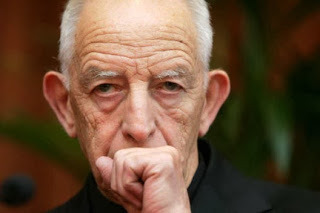 Clonard is a pFr. Alec Reid died in his sleep in the early hours of last Friday morning. I had been with him the previous Thursday and he was in good form. Talkative, funny and enjoying his hospital tea in St. Vincent’s in Dublin. But his condition deteriorated. I was phoned on Thursday night and told that he only had days. I arranged to travel down on Friday to visit him but shortly after 9am on Friday morning we got word that he had quietly passed in his sleep.
Clonard is a pFr. Alec Reid died in his sleep in the early hours of last Friday morning. I had been with him the previous Thursday and he was in good form. Talkative, funny and enjoying his hospital tea in St. Vincent’s in Dublin. But his condition deteriorated. I was phoned on Thursday night and told that he only had days. I arranged to travel down on Friday to visit him but shortly after 9am on Friday morning we got word that he had quietly passed in his sleep. I was deeply shocked and saddened at his death. For forty years I have known him as a good friend to me and my family, and a selfless and unstinting worker in the search for justice and peace. In the midst of hard times Fr. Reid was always there offering comfort and solidarity and advice.
He was one of the good guys. His death is a huge loss to all the people of Ireland, to his fellow priests in the Redemptorist community and to his family, especially his sisters Margaret and Maura, his Aunt Ita, his wider family circle and his many friends.
I first met Fr. Alec in the Cages of Long Kesh, where I was interned, in the mid 1970s. He and Father Des Wilson were pioneers of peace making in those difficult times. Both men were deeply committed to living the gospel message and to making it relevant to the particular circumstances in which they ministered. They developed dialogue with loyalists and facilitated meetings between us and some prominent people from loyalist paramilitarism. Both were tenacious peacemakers.
I met him again on Easter Sunday after my release in 1976, when at my request he and Fr. Des – who thankfully is still with us - intervened to negotiate an end to the inter-republican feuds in Belfast. Theysucceeded in establishing an arbitration and mediation process between the different republican organisations.
Fr. Alec had more freedom than most priests because he belonged to an order – the Congregation of the Most Holy Redeemer, popularly known as the Redemptorists – which fully supported the work he was doing. The Redemptorist mission is to ‘preach the values and the blessings of the Christian Gospel to people everywhere but particularly to the poor, the marginalised and the downtrodden’.
The Sagart was ordained in 1957and was appointed to Clonard Monastery several years later. From 1969 and throughout the intervening years of conflict Fr. Reid was constantly involved in a number of special peace-making ministries. The objective of these was to give comfort and support to the people living at the coal-face of the violence; helping prisoners and their families; and promoting understanding and reconciliation between the people of Belfast. He was also Chaplain to and worked closely with the Traveller community in Belfast.
Another Clonard ministry was to foster dialogue and friendship between the separated Christians of Belfast, an enterprise he took especially to heart, working tirelessly to move the conflict off the streets and onto the conference table.
Fr. Alec was also a friend of the prisoners and part of the line of communication between them and the British Government during the first Hunger Strike in 1980. He actively encouraged initiatives in support of the H Block blanketmen and the Armagh women. It was Fr. Reid who suggested that we meet with Cardinal O Fiaich on the prison issue and it was Fr. Reid who persuaded the Cardinal to visit the republican political prisoners on the blanket protest in July 1978.
Afterward the Cardinal, then Archbishop, O Fiaich, condemned the conditions under which the prisoners were being held, and said: “Having spent the whole of Sunday in the prison, I was shocked at the inhuman conditions prevailing in H-Blocks 3,4 and 5 where over 300 prisoners were incarcerated. One would hardly allow an animal to remain in such conditions, let alone a human being. The nearest approach to it that I have seen was the spectacle of hundreds of homeless people living in sewer pipes in the slums of Calcutta.”
The Cardinal informed the then British Secretary of State, Humphrey Atkins, of these meetings and tried to mediate a resolution of the prison protest. It failed. The British were determined to break the prisoners.
Fr. Reid was devastated by the commencement of the first hunger strike. He had lobbied ferociously for an end to the dispute. The stress of trying and failing to get a resolution of this issue took its toll and he took seriously ill. I used to visit Fr. Alex in Drogheda hospital. On one occasion Colette and I found him in a very distressed state as the health of the hunger strikers deteriorated. Paradoxically, while the plight of the prisoners and their families and the ongoing conflict continued to wear him down, he took great comfort from the messages of support that the blanket men had smuggled out to him.Some of his friends arranged to send him to Rome where the Redemptorist main headquarters is. Fr. Alec enjoyed Rome; he delighted in wandering through the city and eventually finding his way back to the Redemptorist House at nightfall. One day, on May 13th 1981, 8 days after Bobby Sands died on Hunger Strike, Fr. Alec was in St. Peter's square, reflecting on events in Ireland, the hunger strike and how different this was to Belfast with its daily bombing attacks and intermittent gun battles. As he tried to get closer to where the Holy Father, John Paul II’s procession was passing an armed man dashed forward close to the Sagart and shot the Pope.The Sagart, in a state of some understandable shock and concern for the Pope’s well being, made the mistake of recounting his experiences to friends back home. It was a story that was to be told and retold with suitable irreverence in typical black Belfast style for years after that.It wasn’t until July of the following year that the Sagart was allowed to return to Ireland but on condition that he didn't come north. His superiors were afraid that his fragile health could be undermined if he was allowed to become re-involved in his previous activities.When he eventually did we resumed our conversations about the conflict, its causes and how it might be ended. It was obvious that dialogue was the necessary first step. In the early 1980s we tried to commence a process of engagement with the Catholic Hierarchy, the SDLP, and the Irish and British governments. They were all rebuffed. The breakthrough came after Fr. Reid wrote a letter to John Hume on May 19 1986. John phoned the monastery the next day and he arrived at Clonard on May 21st.
Towards the end of 1987 we decided that John and I would begin party-to-party meetings. The Sagart formally wrote to both of us as ‘an interested third party’ inviting Sinn Féin and the SDLP to ‘ explore whether there could be agreement on an overall nationalist strategy for justice and peace.’ He presented us with a paper entitled ‘A concrete proposal for an overall political strategy to establish justice and peace in Ireland.’
I brought the invitation to our Ard Chomhairle. It responded positively and John and I met on Monday January 11th 1988 for several hours. For the first time our meeting was publicised and there was an immediate and generally hostile response from the governments, the other political parties and sections of the media. Jump forward 25 years and it is the same sections of the media and in many cases the same journalists who are still busy peddling their anti-Sinn Féin agenda.
Fr. Reid never allowed any of it to distract him. He was tenacious in his pursuit of peace. He wrote copious letters to political leaders here and in Britain and engaged in countless meetings with politicians and government’s seeking to persuade them to start the process of talking. He saw good in everyone and lived the gospel message. His was the gospel of the streets.
He was there during the first hunger strike and became ill as a consequence of the stress. He was there during the battle of the funerals including the funerals of the IRA volunteers killed at Gibraltar. He was in Milltown Cemetery when the mourners were attacked. Three were killed and over 60 wounded. Several days later he administered the last rites to the two British soldiers killed at the subsequent funeral of one of the victims Caoimhin MacBradaigh.
Fr. Reid also helped broker talks between Sinn Féin and Fianna Fáil and subsequently the Irish government and Sinn Féin. In 1999, at my request, he became involved in the ongoing efforts to locate the remains of those who had been killed and secretly buried by the IRA and others. After several years it became apparent that our initial hope that all of the remains would be located quickly was naive. He and I discussed this and consequently we put to the governments a proposal that experts in the recovery of remains, using high-tech equipment and archaeological methods should be employed.
Later in 2005 he was an independent witness, along with Rev Harold Good, to the IRA putting its arms beyond use and during this time he was also involved in trying to develop a peace process in the Basque country.
Today we brought him to his last resting place in the Redemptorist plot in Milltown cemetery. Earlier hundreds of his religious colleagues, political and community leaders and the people of west Belfast attended his funeral mass in Clonard.
The Sagart lived a full life. His contribution to peace in Ireland is immeasurable. There would not be a peace process at this time without his diligent doggedness and his refusal to give up. He remained through all these turbulent times a good and simple priest. He was forthright, funny and totally dedicated to upholding the dignity of human beings. He was an active proponent of equality, particularly of a woman’s right to equality.
He was also a proud Tipperary man and a hurling enthusiast. His last words to me were “Up Tipp”.
Go ndeanfaid Dia trocaire ar a n’anam dilse. [image error]
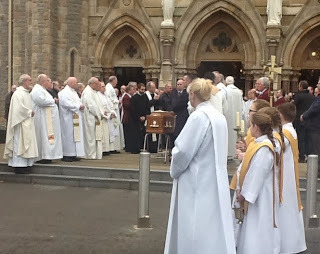
Published on November 27, 2013 14:35
November 21, 2013
The MRF - taking out unwanted members of the public
The BBC Panorama programme on the Military Reaction Force shines a light on the one aspect of Britain’s dirty war in Ireland. The existence of the MRF has been known for over 30 years but John Ware’s documentary usefully provides new information on a secret British Army unit that operated with impunity in the early 70s. The use of counter-gangs, like the MRF and the Force Reconnaissance Unit (FRU) and others; of agents and informers; and of specialist military units is as old as war itself. The British military establishment has long made use of these tactical tools. I am quite confident it is passing that experience on to its current crop of young officers in Sandhurst.
As used by successive British governments in Ireland this involved reshaping the judiciary, the law, the police and the media to suit the political and military objectives of the generals and the politicians. According to Frank Kitson the British Army’s foremost proponent of counter-insurgency tactics: ‘Everything done by a government and its agents in combating insurgency must be legitimate. But this does not mean that the government must work within exactly the same set of laws during an emergency as existed before hand. The law should be used as just another weapon in the government’s arsenal, in which case it becomes little more than a propaganda cover for the disposal of unwanted members of the public.’That was the job of the MRF. To kill unwanted members of the public. If unarmed republicans or civilians were killed that was acceptable.
In every major conflict in the 20th century and in the colonial struggles for independence – in Algeria and Vietnam, in Kenya and Mozambique, in Aden and Cyprus – the same strategies were employed. The court case taken by Kenyans who were imprisoned and tortured by the British Army in Kenya and which was covered extensively in the Guardian provides one example outside of Ireland of these practices at work.
It is a sad fact that the conflict in Ireland has left thousands of families bereaved and hurting. In the last month there have been anniversaries to mark the Enniskillen bomb, the Greysteel Massacre, the Shankill bomb and other similar events. There has also been the recent publication of ‘Lethal Allies’. Through a detailed examination of the facts this book connects British state forces with 120 deaths of civilians in a five year period in the 1970s. And it reveals the way in which the political and judicial system covered up these actions. This is what happens when politicians surrender their power to the generals. When diplomacy ends and war takes over and generals and their armies do what they have been trained to do, which is defeat the enemy.
I am an Irish republican. British government involvement in Irish affairs and the partition of my country are in my view at the core of the problem but I recognise that others, for example, the unionists, have a different view and their own sense of truth. There will be those in the British system who also have a different analysis. There are many differing narratives. Different perspectives on the causes of the conflict, what happened and who was responsible. All of these narratives have their own truth. There is no single voice for victims. Some want truth. Some want judicial processes. We need to set all of these narratives side by side and respect them all.The war is over. But the legacy of conflict remains with us. The pain from decades of conflict is, for many, as real today as it was when a loved one was killed.
US diplomats Richard Haass and Meghan O Sullivan are currently conducting intensive negotiations to deal with outstanding aspects of the Good Friday and other Agreements. These include the legacy issues. Everyone who has an interest in peace knows that the past cannot be allowed to be an obstacle to building the future. So, there needs to be a measured and inclusive debate on all of the issues involved.
Sinn Féin has proposed that an international, independent truth recovery process underpinned in legislation should be established. Others have different ideas of how this issue should be dealt with and that is fair enough, but we need to take this opportunity to move the process forward in a way that listens to, respects and treats all victims on the basis of equality, and also builds the future for the survivors.
Published on November 21, 2013 15:06
November 20, 2013
Unshackling the Past
US diplomats Richard Haass and Meghan O Sullivan are currently conducting intensive and inclusive negotiations to deal with outstanding aspects of the Good Friday and other Agreements. These include the legacy issues arising from the conflict.
Everyone who has an interest in building the peace knows that the past cannot be allowed to be an obstacle to building the future. So, there needs to be a measured and inclusive debate on all of the issues involved.Today the north’s Attorney General John Larkin has put forward his ideas on dealing with one aspect the legacy of the past - the issue of prosecutions. He has expressed a view that there should be no prosecutions, inquests or inquiries for incidents before the Good Friday Agreement.
Mr. Larkin has also said that the current position favours non-state forces. That is not the case. The British government is in breach of international agreements and commitments in respect of the Pat Finucane Inquiry and the Dublin and Monaghan bombs. And to all intents and purposes there is an amnesty for the British state forces and their allies. While over the years thousands of republicans and innocent nationalists have served very lengthy prison sentences.I have not had the chance to read the Attorney General’s full remarks on this issue. But I think it is a good thing that the Haass talks have encouraged people - he has had several hundred submissions – to express their opinions, including victims.
Our wider society needs to have this debate. We need a sensitive, measured, reasoned and intelligent debate on these issues which recognises that any mechanism put in place must be victim centred and that it has to be done on the basis of equality.The conflict is over but the legacy of conflict remains with us. The pain, suffering and the tragedies from decades of conflict are, for many, as real today as they were when they first occurred.
Sinn Féin believes that if legacy issues are located in the framework of conflict resolution and of the broader peace process then these matters will be addressed in way which will heal divisions, consolidate the peace and become guarantors for the future. Truth recovery and acknowledgement are critical to dealing with the past and can become a powerful dynamic in the quest for reconciliation.
Sinn Féin has proposed that an international, independent truth recovery process underpinned in legislation should be established. Others have different ideas of how this issue should be dealt with and that is fair enough, but we need to take this opportunity to move the process forward in a way that looks after the victims but also builds the future for the survivors.
It is necessary that in coming to the issue of truth and reconciliation that we all recognise that there are many different narratives to this story. All of these narratives have their own truth. There is no single voice for victims. Some want truth. Some want judicial processes. There are also different perspectives on the causes of the conflict, what happened and who was responsible.
I am an Irish republican. British government involvement in Irish affairs and the partition of this country are in my view at the core of the problem but I recognise that others, for example, the unionists have a different view and their own sense of truth, Fine Gael may have its own analysis. Or Fianna Fáil and others including the British government. We need to set all of these narratives side by side and respect them all.
How do we encourage such a debate? The starting point must be a recognition by the Irish government that this is a crucial matter and that as a co-equal partner with the British government it has a responsibility to look after everyone on this island including our unionist neighbours.
In this context I am looking to the government to encourage a joined-up inclusive, thoughtful discussion aimed at unshackling us from the past. We need a process that can ensure that the past is never repeated and which is aimed at forging a more hopeful future for the people who have survived the conflict and for our children and grandchildren.
In this respect I am very conscious of the upcoming state visit by the President to Britain. It is important that these seismic changes can be measured by people not just in the palaces but also in the laneways and hillsides across this island.
Finally in our submission to the Haass talks Sinn Féin submitted a paper ‘Addressing Legacy Issues – Building a Common Future’. We have also made submissions on Flags and emblems and on parades. All of these are available at www.sinnfein.ie
Everyone who has an interest in building the peace knows that the past cannot be allowed to be an obstacle to building the future. So, there needs to be a measured and inclusive debate on all of the issues involved.Today the north’s Attorney General John Larkin has put forward his ideas on dealing with one aspect the legacy of the past - the issue of prosecutions. He has expressed a view that there should be no prosecutions, inquests or inquiries for incidents before the Good Friday Agreement.
Mr. Larkin has also said that the current position favours non-state forces. That is not the case. The British government is in breach of international agreements and commitments in respect of the Pat Finucane Inquiry and the Dublin and Monaghan bombs. And to all intents and purposes there is an amnesty for the British state forces and their allies. While over the years thousands of republicans and innocent nationalists have served very lengthy prison sentences.I have not had the chance to read the Attorney General’s full remarks on this issue. But I think it is a good thing that the Haass talks have encouraged people - he has had several hundred submissions – to express their opinions, including victims.
Our wider society needs to have this debate. We need a sensitive, measured, reasoned and intelligent debate on these issues which recognises that any mechanism put in place must be victim centred and that it has to be done on the basis of equality.The conflict is over but the legacy of conflict remains with us. The pain, suffering and the tragedies from decades of conflict are, for many, as real today as they were when they first occurred.
Sinn Féin believes that if legacy issues are located in the framework of conflict resolution and of the broader peace process then these matters will be addressed in way which will heal divisions, consolidate the peace and become guarantors for the future. Truth recovery and acknowledgement are critical to dealing with the past and can become a powerful dynamic in the quest for reconciliation.
Sinn Féin has proposed that an international, independent truth recovery process underpinned in legislation should be established. Others have different ideas of how this issue should be dealt with and that is fair enough, but we need to take this opportunity to move the process forward in a way that looks after the victims but also builds the future for the survivors.
It is necessary that in coming to the issue of truth and reconciliation that we all recognise that there are many different narratives to this story. All of these narratives have their own truth. There is no single voice for victims. Some want truth. Some want judicial processes. There are also different perspectives on the causes of the conflict, what happened and who was responsible.
I am an Irish republican. British government involvement in Irish affairs and the partition of this country are in my view at the core of the problem but I recognise that others, for example, the unionists have a different view and their own sense of truth, Fine Gael may have its own analysis. Or Fianna Fáil and others including the British government. We need to set all of these narratives side by side and respect them all.
How do we encourage such a debate? The starting point must be a recognition by the Irish government that this is a crucial matter and that as a co-equal partner with the British government it has a responsibility to look after everyone on this island including our unionist neighbours.
In this context I am looking to the government to encourage a joined-up inclusive, thoughtful discussion aimed at unshackling us from the past. We need a process that can ensure that the past is never repeated and which is aimed at forging a more hopeful future for the people who have survived the conflict and for our children and grandchildren.
In this respect I am very conscious of the upcoming state visit by the President to Britain. It is important that these seismic changes can be measured by people not just in the palaces but also in the laneways and hillsides across this island.
Finally in our submission to the Haass talks Sinn Féin submitted a paper ‘Addressing Legacy Issues – Building a Common Future’. We have also made submissions on Flags and emblems and on parades. All of these are available at www.sinnfein.ie
Published on November 20, 2013 07:35
Gerry Adams's Blog
- Gerry Adams's profile
- 29 followers
Gerry Adams isn't a Goodreads Author
(yet),
but they
do have a blog,
so here are some recent posts imported from
their feed.



